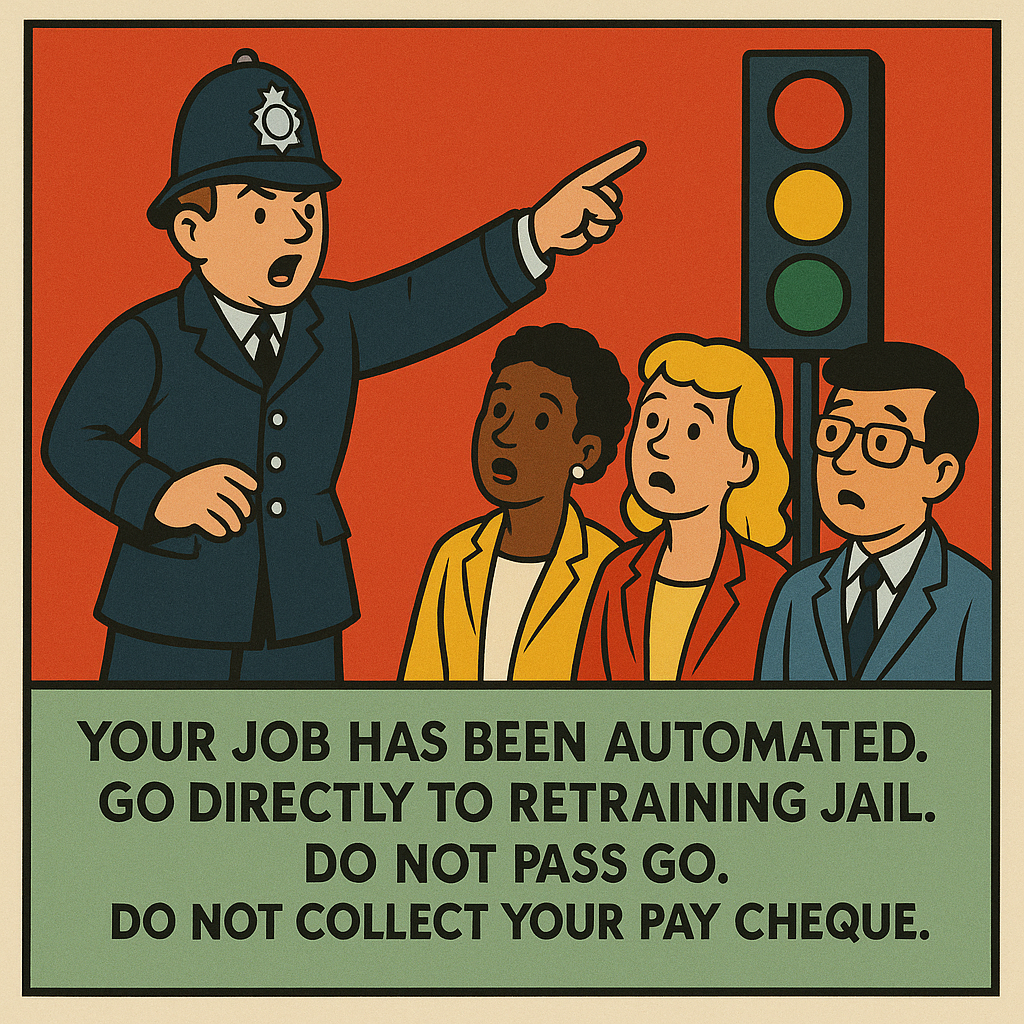Traffic Lights and Traffic Cops
A RED/AMBER/GREEN framework for evaluating job exposure to AI displacement. The RED, AMBER and GREEN categories memorialise specific job characteristics.

In homage to Susan Calvin’s, 1947 appearance in Isaac Asimov’s Liar!, I’m adding robo-psychologist to my list of emergent jobs for humans. More seriously, my friend ChatGPT and I have devised a traffic light scorecard for job risk due to AI automation:
- High Risk: RED; Routine, Explicit, Digital
- Medium Risk: AMBER; Augmentable, Mechanisable, bounded, Encodable, Removable
- Low Risk: Gregarious, Regulated, Embodied, Educative, Nebulous
Of these categories, RED is relatively straightforward to sniff test. Does the job entail doing a small variety of tasks again, again and again? Is there an extremely explicit set of instructions to train new recruits? Is it desk bound using a computer or a phone? If the answer to all three questions is Yes, then beware – your card is marked.
Characteristics in the other categories need more explanation and next week’s post is a deeper dive on this RED/AMBER/GREEN job evaluation framework.
The first characteristic in the AMBER category is a case in point, requiring more thought. Augmentable jobs are those that are already partly replaceable by AI, but cannot yet be fully automated. Whether the job is at medium term risk depends on whether the automatable part is the fundamental essence of the role or whether it is the peripheral tasks necessary to get the core job done. If the core is automatable then today’s augmentation becomes tomorrow’s full automation as the peripheral tasks or requirements are stripped away. Augmentable jobs with that characteristic are firmly in the AMBER category. In contrast, policing is not amber, despite the desk related aspects already being partially automatable. I can think of many reasons why people may be attracted to the police role, including apprehending villains, helping the community, harassing the community, driving fast cars or even dressing up in uniforms. But I’d hazard that not many join the force for the sheer joy of reviewing unending video footage or filling in case paperwork. The good news for anyone drawn to policing is that the more tedious aspects of the role are exactly the ones that AI can most easily automate. The other good news is that crime isn’t going away anytime soon, so nor is policing. Even if AI has taken our jobs we will still need keeping safe or keeping under control. Given current police shortages and rising crime rates, I’d be amazed if we find ourselves with too many police to perform the newly streamlined roles in the coming years.
While we’re talking policing, I’m not a regular customer of the Wiltshire constabulary myself, but I do occasionally and unintentionally add a bit of variety to a policeman’s life…
Good Cop
I recently rode home from the train station in a police Volvo - the sort they use for high speed road chases, although we didn’t actually exceed 20mph on the 400m journey to my house through narrow medieval streets. The policeman wasn’t forthcoming about why precisely he was waiting at the train station, but he very kindly volunteered to drive me home, recognising the potential for my involuntary off-piste adventure to end with a ride in a different sort of emergency service under blues and twos.
What a lovely guy.
Bad Cop
The above heart warming story was not actually my first blind induced encounter with the law. At the age of 22 and only relatively recently registered blind I hitch hiked solo from Nottingham to Brussels. It’s hard to fathom why I thought this made any sense, as I could no longer read signs or maps, I didn’t speak Flemish and mobile phones weren’t even a thing. Presumably my Belgian friend and I met at the most famous statue in Brussels. [Just as an aside, stack rank The Manneken Pis, Nelson’s Column and Michelangelo‘s David as national pride worthy symbols for the Belgians, the Brits and the Italians]. I had barely started my journey, but was losing confidence in my ride thumbing skills before even breaking my duck. My short-lived excitement when a Range Rover pulled on to the shoulder deflated with a resounding pop when the fluorescent orange stripes and roof light penetrated my limited vision. 15 minutes of abusive hectoring on the time wasting stupidity of flagging down busy police vehicles then morphed into an intensive grilling on where precisely I had stashed my drugs. But thankfully British police don’t carry firearms, and at least on this occasion they didn’t feel the need for a roadside cavity search.
That’s not a pleasant image to leave you with, but it’s fortunately not what ChatGPT chose for this post’s cover art.